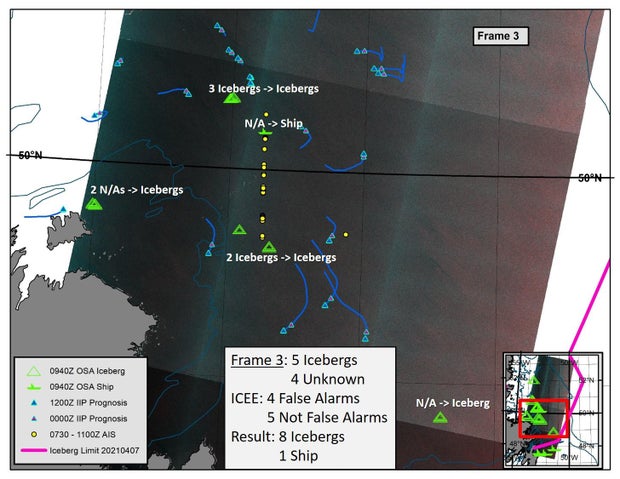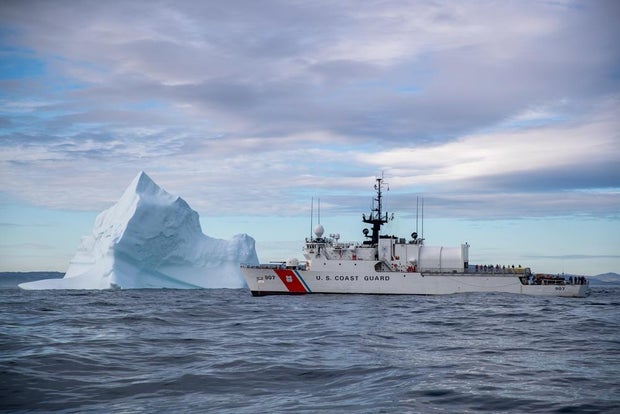It was the “unsinkable ship” until eventually it was not.
Ten minutes prior to the maiden voyage of the Titanic ended in calamity, a radio operator aboard the close by SS Californian signaled that there was an iceberg in the ship’s path. The warning was dismissed, and the large collision that followed expense in excess of 1,500 lives, prompting a wave of maritime innovations: sonar and radar navigation capabilities, lifeboat drills and the generation of the International Ice Patrol (IIP.)
Now, 110 years soon after the sinking of the Titanic, the U.S. authorities is developing a new technological innovation that’s made to detect and report icebergs to the maritime group.
“Procedure Titanic,” spearheaded by the Department of Homeland Security’s Science and Know-how Directorate, will fuse satellite-based radar imagery with ship reporting techniques to allow the U.S. Coast Guard to discover glacial masses all through the North Atlantic Ocean in authentic time.
Supplied by U.S. Coast Guard
Floating icebergs like the just one the Titanic struck on April 15, 1912, nevertheless pose navigational hazards right now for ships, oil rigs and armed service property, claims Kathryn Coulter Mitchell, the DHS senior formal doing the obligations of the beneath secretary for science and engineering, explained to CBS News.
“The Titanic in fact struck the iceberg at a latitude equal to the Massachusetts region,” Coulter Mitchell said. “All those of us in this mission room never normally realize just how significantly south, how widespread the iceberg mission is.”
The 16-individual IIP is funded by 17 nations bordering the trans-Atlantic, but is operated by the U.S. Coast Guard for the duration of ice season, from February as a result of July.
The patrol originally relied on cutters deployed by the U.S. Coast Guard to study icebergs but switched to aircraft monitoring following Globe War II. Nowadays, the IIP pilots 9-day aircraft missions each two weeks.
Delivered by U.S. Coast Guard
“Operation Titanic” will mark a “total departure from [U.S. Coast Guard’s] a lot of a long time of flying fastened-wing aircrafts to identify icebergs,” said Coastline Guard Commander Marcus Hirschberg with the International Ice Patrol. .
Delivered by U.S. Coastline Guard
“Aerial ice reconnaissance” routinely provides up to a lot more than $10 million in once-a-year expenses for the U.S. Coastline Guard. Further than the price tag tag, C-130J aircrafts that fly bi-weekly missions – approximately 500 aircraft hours for each time – are also the U.S. Coast Guard’s most really sought soon after aviation belongings.
“We are heading to get a ton far more bang for our buck after we can use those aircraft hours for disaster reaction, counterdrug operations, migrant functions and other locations,” Hirschberg additional.
The U.S. govt has invested $4 million in “Procedure Titanic” to day, with revenue drawn from the Science and Know-how Directorate’s Research, Growth and Innovation fund.
And although very similar systems are at this time applied by the U.S. federal government in rescue missions and flood response, the new satellite know-how – which will draw photographs from the European Space Agency satellites, U.S. business providers and Canada’s RADARSAT Constellation – will be the initial of its variety to access worldwide satellite data.
The satellite-primarily based radar imagery remains thoroughly operational in dark, overcast conditions that normally avert standard aircraft operations. Hirschberg referred to as it a “activity-changer for forecasting the season.”
“When the Coast Guard came to us with this, the hope was to get over the problems with [technology] that is immune to darkness and overcast, so we can see further more upstream of the transatlantic delivery lines than we ever have been before to difficulty for a longer time-term predictions,” Coulter Mitchell mentioned.
“For forecasting, we are looking at icebergs that are way far North that we can not attain with aircrafts, even traveling from St. John’s Newfoundland,” explained Hirschberg.
“A ton of occasions there is certainly a mechanical problem with the plane, inclement weather, or we are unable to get the hangar door open due to the fact of substantial winds. So we do eliminate a ton of options to fly,” he additional.
Glaciers in pieces of the North Atlantic are melting so swiftly that modifications can be seen from space. The most up-to-date “Arctic Report Card,” published by the Countrywide Oceanic and Atmospheric Administration (NOAA), found the location warms two times as speedy as the rest of the Earth, ensuing in the rapid reduction of ice protect.
“We see so a lot year-to-time variability,” Hirschberg told CBS News. “In 2019, we experienced 1,500 icebergs go south of 48° North latitude – about exactly where the Titanic sank. In 2020, we had a solitary iceberg move that limit.”
U.S. Coastline Guard officials anticipate employing satellite photos will assistance the department navigate improvements introduced on by a transforming local climate.
The Global Ice Patrol is slated to test-operate “Operation Iceberg” for two many years, beginning in 2023 just before launching the plan.








More Stories
Attendance at IEEE’s STEM Summer Camp Breaks Records
Best Free Android Emulators for Windows 7, 8.1, 10 PC in 2021
What is Bitly & How Does It Work? –